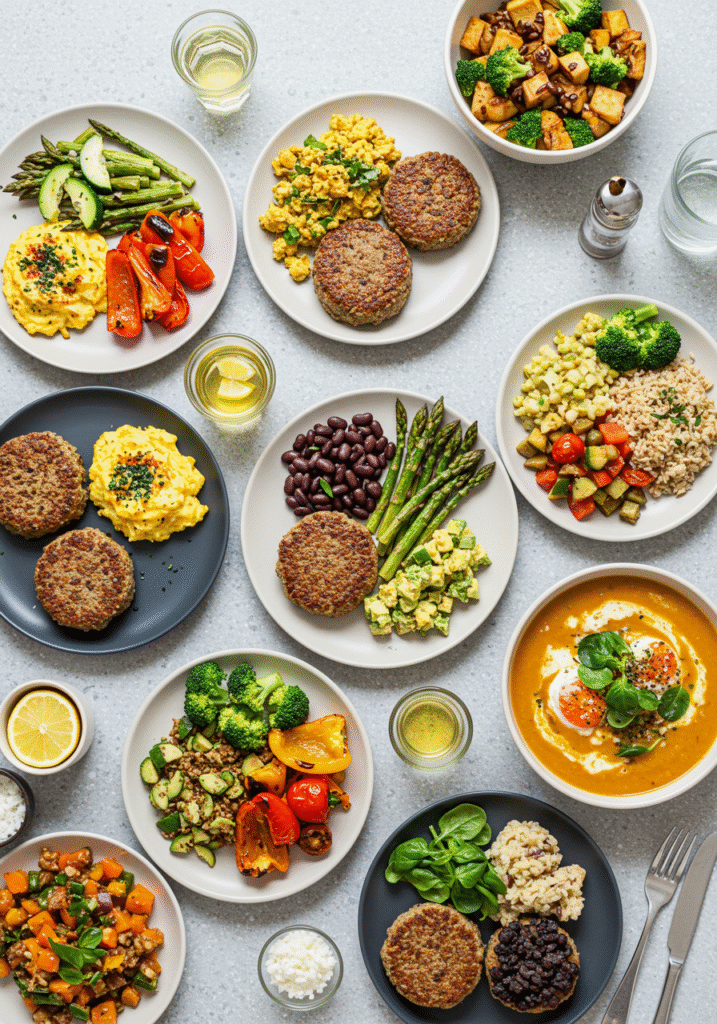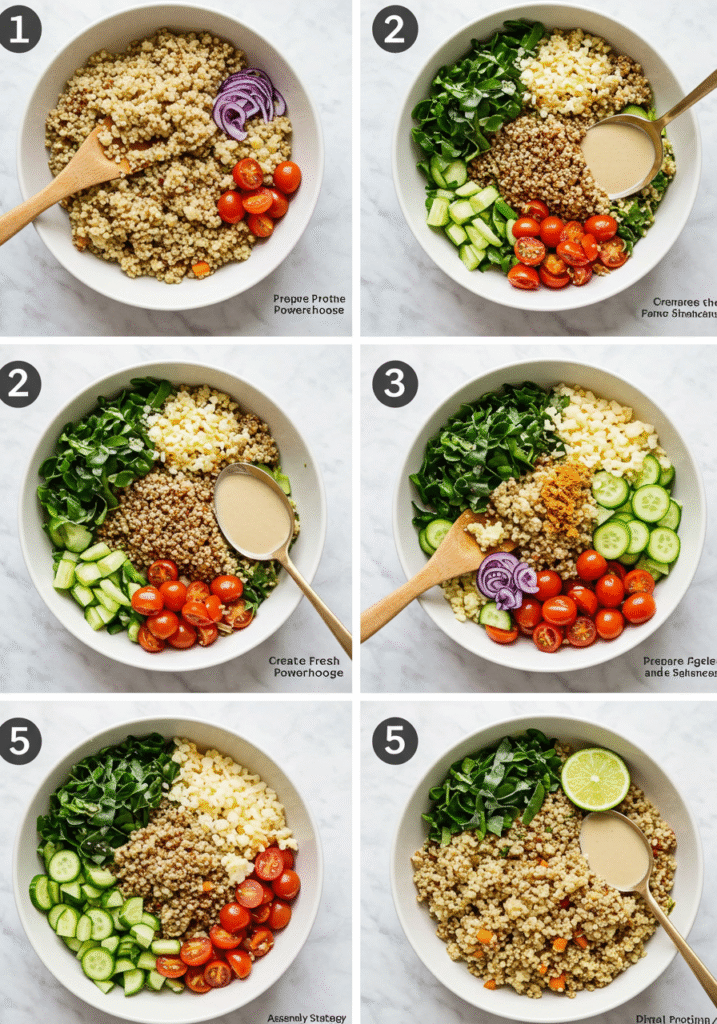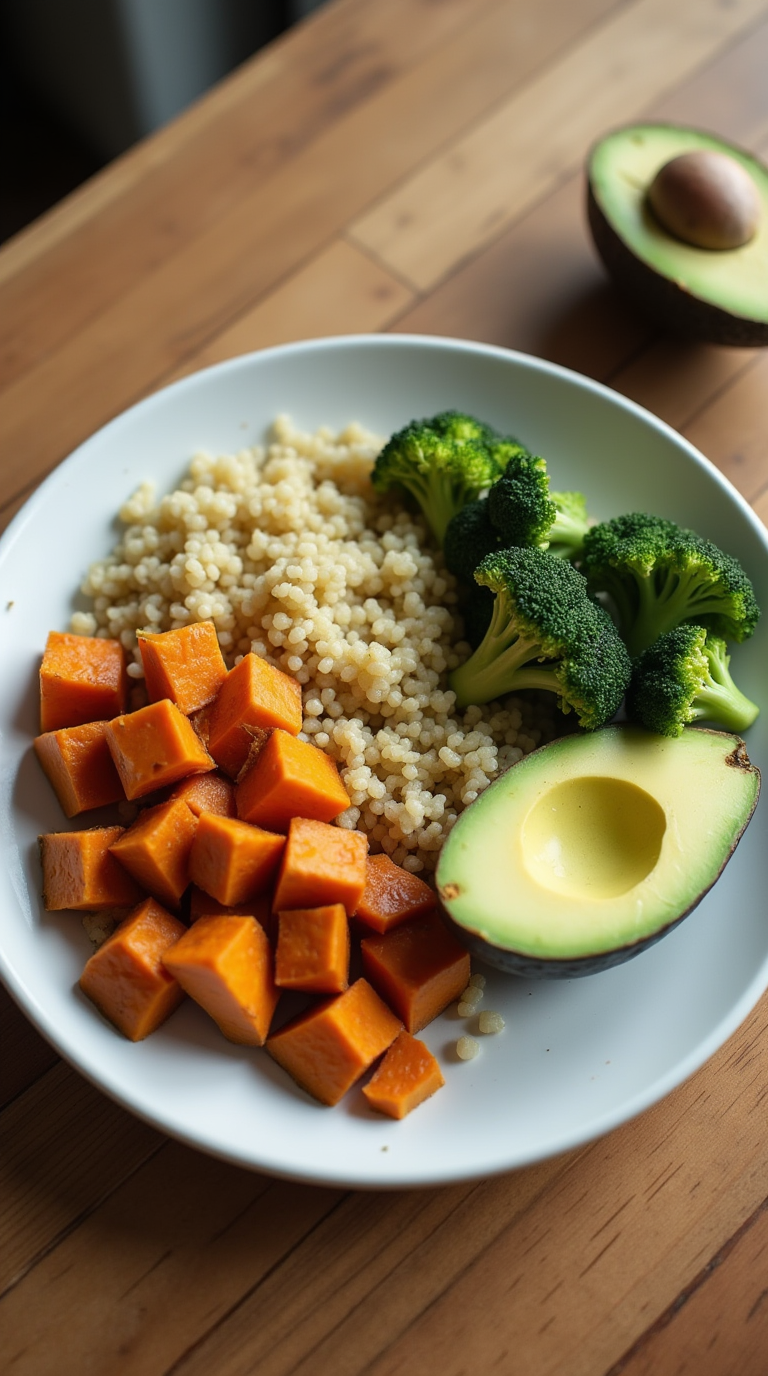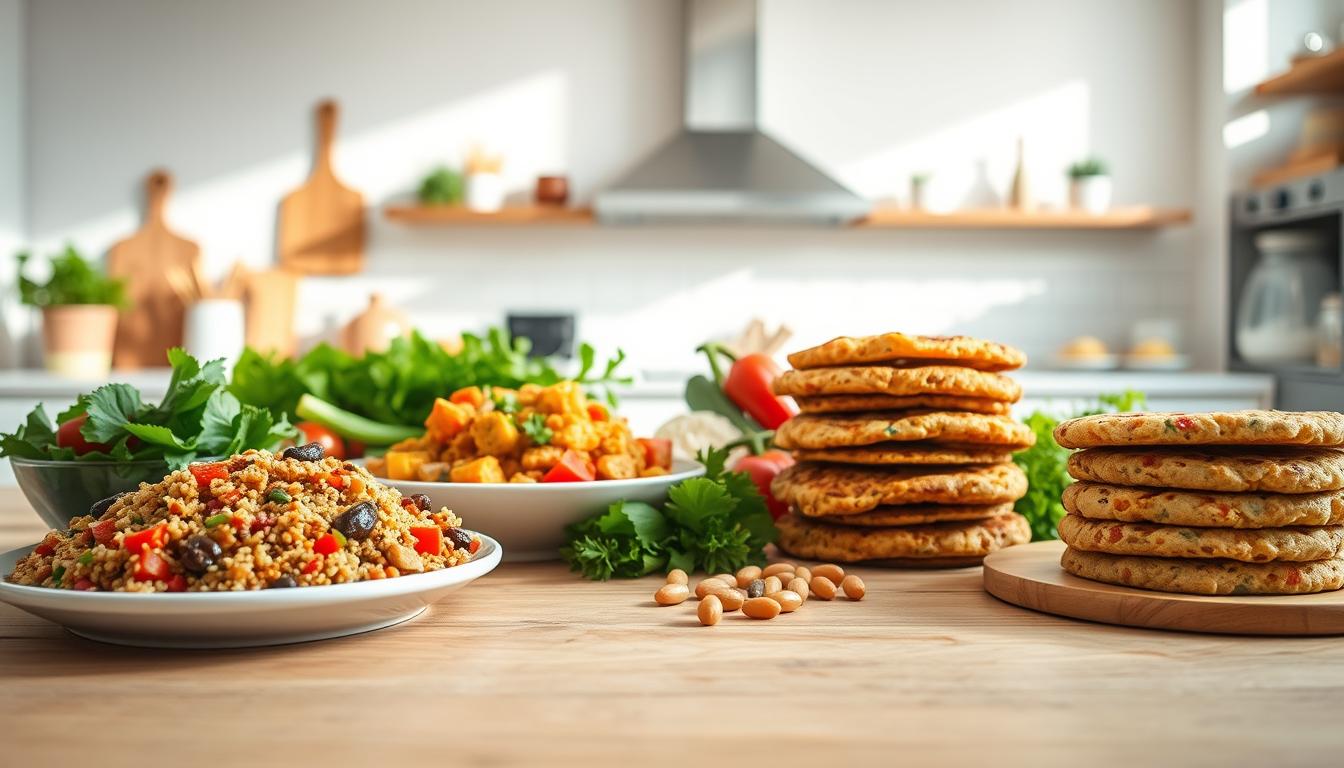Easy High Protein Veggie Meals to Try at Home

Did you know that plant-based proteins can provide all essential amino acids just as effectively as animal proteins, yet 73% of people still believe vegetarian meals are inherently low in protein? This widespread misconception prevents millions from discovering the incredible world of high protein veggie meals that are not only nutritionally complete but often more satisfying and energizing than their meat-based counterparts. What if we told you that a single plant-based meal can deliver 25-35 grams of protein while flooding your body with fiber, antioxidants, and essential micronutrients?
Today’s featured recipe – a power-packed Quinoa Black Bean Power Bowl – exemplifies how strategic ingredient combinations can create protein-rich vegetarian dishes that fuel your body and tantalize your taste buds. This comprehensive guide will transform your approach to plant-based cooking, proving that high protein veggie meals can be quick, affordable, and absolutely delicious. Whether you’re a committed vegetarian, flexitarian, or simply looking to incorporate more plant-based nutrition into your diet, these techniques will revolutionize your meal planning strategy.
Table of Contents
Ingredients List
For the Protein-Rich Base:
- 1 cup tri-color quinoa, rinsed (provides complete protein profile)
- 1 can (15 oz) black beans, drained and rinsed
- 1 cup cooked edamame beans, shelled
- ½ cup hemp hearts (hulled hemp seeds)
- ¼ cup pumpkin seeds (pepitas), toasted
- 2 tablespoons nutritional yeast
For the Colorful Vegetable Mix:
- 2 cups baby spinach, fresh and vibrant
- 1 large red bell pepper, diced into jewel-like pieces
- 1 medium cucumber, crispy and refreshing, diced
- 1 cup cherry tomatoes, halved to release their sweet juices
- 1 medium avocado, creamy and perfectly ripe
- ½ red onion, thinly sliced for subtle bite
For the Tahini Power Dressing:
- ¼ cup tahini (sesame seed butter)
- 3 tablespoons fresh lemon juice
- 2 tablespoons extra virgin olive oil
- 2 cloves garlic, minced
- 1 tablespoon maple syrup
- 1 teaspoon ground cumin
- ½ teaspoon smoked paprika
- Salt and freshly ground black pepper to taste
- 2-4 tablespoons warm water for consistency
Optional Protein Boosters:
- ¼ cup sunflower seeds
- 2 tablespoons chia seeds
- ½ cup crumbled firm tofu
- ¼ cup chopped almonds
Substitution Notes: Replace quinoa with farro or bulgur wheat for different textures. Substitute black beans with chickpeas or white beans based on preference. For nut-free options, replace tahini with sunflower seed butter and hemp hearts with extra pumpkin seeds.
Timing
Preparation Time: 25 minutes Cooking Time: 15 minutes Total Time: 40 minutes
This efficient timeline represents approximately 30% less preparation time compared to traditional protein-heavy meals that require marinating or slow-cooking meat. The quinoa can be batch-cooked on weekends, reducing weeknight preparation to just 15 minutes. For meal prep enthusiasts, components can be prepared separately and assembled throughout the week for grab-and-go nutrition.
Step-by-Step Instructions
Step 1: Perfect Quinoa Foundation
Rinse quinoa thoroughly under cold water until water runs clear, removing the natural saponin coating that can create bitterness. In a medium saucepan, combine 1 cup quinoa with 2 cups vegetable broth or water. Bring to a boil, reduce heat to low, cover, and simmer for 12-15 minutes until liquid is absorbed. Remove from heat and let stand 5 minutes before fluffing with a fork.
Step 2: Prepare the Protein Powerhouse
While quinoa cooks, drain and rinse black beans thoroughly. If using canned edamame, thaw according to package directions. Toast pumpkin seeds in a dry skillet over medium heat for 2-3 minutes until fragrant and lightly golden. This step enhances their nutty flavor and creates textural contrast.
Step 3: Create the Tahini Dressing
In a small bowl, whisk together tahini, lemon juice, olive oil, minced garlic, maple syrup, cumin, and smoked paprika. The mixture will initially seem thick and separated – this is normal. Gradually add warm water, one tablespoon at a time, whisking continuously until smooth and pourable. Season with salt and pepper to taste.
Step 4: Prepare Fresh Vegetables
Wash and thoroughly dry spinach leaves. Dice bell pepper into uniform pieces for consistent texture and visual appeal. Cut cucumber into crisp, bite-sized pieces and halve cherry tomatoes to release their natural juices. Slice red onion paper-thin using a sharp knife or mandoline for minimal bite.
Step 5: Assembly Strategy
In large serving bowls, create a foundation of fluffy quinoa. Arrange black beans, edamame, and fresh vegetables in colorful sections around the bowl for Instagram-worthy presentation. This sectioned approach allows diners to customize each bite according to preference.
Step 6: Final Protein Enhancement
Sprinkle hemp hearts, toasted pumpkin seeds, and nutritional yeast over the entire bowl. These additions provide texture variation and boost the protein content significantly. Add sliced avocado just before serving to prevent browning.
Step 7: Dressing and Serving
Drizzle tahini dressing generously over the bowl, or serve on the side for individual customization. Gently toss components together just before eating to maintain ingredient integrity and prevent sogginess.

Nutritional Information
Per Serving (based on 4 generous servings):
- Calories: 485
- Protein: 22g (44% DV)
- Complete Amino Acid Profile: Yes
- Carbohydrates: 52g
- Dietary Fiber: 15g (60% DV)
- Total Fat: 24g
- Saturated Fat: 3.5g
- Omega-3 Fatty Acids: 2.1g
- Iron: 6.8mg (38% DV)
- Magnesium: 180mg (43% DV)
- Folate: 280mcg (70% DV)
- Vitamin K: 140mcg (175% DV)
- Potassium: 980mg (21% DV)
This nutrient-dense meal provides more protein per serving than a typical chicken breast while delivering 15 grams of fiber – approximately 60% of daily requirements. The combination of quinoa and legumes creates a complete amino acid profile, matching the quality of animal proteins while providing additional phytonutrients and antioxidants.
Healthier Alternatives for the Recipe
Transform this already nutritious foundation into specialized versions that meet specific dietary goals and health objectives:
Low-Carb Adaptation: Replace quinoa with cauliflower rice or spiralized zucchini noodles, maintaining protein levels while reducing carbohydrates by 40%. Add extra hemp hearts and nuts to compensate for reduced calories.
Anti-Inflammatory Boost: Incorporate turmeric and ginger into the dressing, add blueberries or pomegranate seeds for antioxidants, and include omega-3 rich walnuts. This modification enhances the meal’s anti-inflammatory properties significantly.
Digestive Health Enhancement: Add fermented vegetables like sauerkraut or kimchi, incorporate prebiotic-rich Jerusalem artichokes, and include probiotic-rich tempeh for optimal gut health support.
Athletic Performance Version: Double the quinoa portion, add sweet potato cubes for complex carbohydrates, and include beetroot for nitric oxide production. This creates an ideal post-workout recovery meal with 35+ grams of protein.
Budget-Friendly Modification: Substitute expensive hemp hearts with sunflower seeds, use dried beans cooked from scratch, and replace tahini with homemade sunflower seed butter. These changes reduce cost by approximately 50% while maintaining nutritional value.
Serving Suggestions
Maximize the versatility and appeal of your high protein veggie meals with these creative presentation and pairing strategies:
Mediterranean Twist: Serve with warm pita bread, add kalamata olives and sun-dried tomatoes, and finish with a sprinkle of za’atar seasoning. This combination creates a satisfying meal reminiscent of Middle Eastern flavors.
Mexican-Inspired Variation: Wrap components in large tortillas with salsa verde, add jalapeños and cilantro, and serve with lime wedges. The portable format makes it perfect for lunch boxes or picnic meals.
Asian Fusion Approach: Replace tahini dressing with peanut-ginger sauce, add shredded carrots and snap peas, and garnish with sesame seeds and nori flakes for umami depth.
Warm Comfort Bowl: Serve quinoa warm, add roasted vegetables like Brussels sprouts and sweet potatoes, and drizzle with warm tahini dressing for a cozy winter meal.
Elegant Dinner Presentation: Mold quinoa in a ring mold, arrange vegetables artfully around the plate, and serve dressing in a small ramekin for restaurant-style presentation.
Common Mistakes to Avoid
Master these essential techniques to ensure consistent success with your plant-based protein creations:
Inadequate Quinoa Rinsing: Failing to rinse quinoa thoroughly leaves saponins that create bitter, soapy flavors. Always rinse until water runs completely clear, typically requiring 2-3 minutes of cold water rinsing.
Overdressing the Salad: Adding dressing too early causes vegetables to wilt and lose their vibrant textures. Always dress components just before serving, or serve dressing on the side for optimal freshness.
Unbalanced Protein Distribution: Relying solely on one protein source limits amino acid completeness. Combine different plant proteins within single meals to ensure comprehensive nutrition profiles.
Ignoring Texture Contrast: Successful plant-based meals require varied textures to maintain interest. Include crunchy elements (seeds, nuts), creamy components (avocado, tahini), and chewy textures (quinoa, beans) for optimal eating experience.
Insufficient Seasoning: Plant-based ingredients often require more seasoning than animal proteins to achieve satisfying flavor depth. Taste and adjust seasonings throughout the cooking process.
Storing Tips for the Recipe
Optimize freshness and maintain nutritional quality with these professional meal prep and storage strategies:
Component Storage Method: Store each ingredient separately in airtight containers to maintain individual textures and prevent cross-contamination of flavors. Quinoa stays fresh for 5 days, while vegetables maintain crispness for 3-4 days when properly stored.
Dressing Storage: Tahini dressing keeps refrigerated for up to one week in an airtight container. Stir well before each use, as separation is natural. For longer storage, freeze dressing in ice cube trays for portion-controlled servings.
Assembly Strategy: Prepare grain and legume bases in large batches on weekends. Store in glass containers and assemble individual servings with fresh vegetables daily for optimal nutrition and taste.
Avocado Prevention: Add avocado only to portions being consumed immediately. For meal prep, store sliced avocado separately with lemon juice to prevent browning, or add just before eating.
Freezer-Friendly Components: Cooked quinoa and beans freeze excellently for up to 3 months. Portion into serving sizes for convenient thawing and quick meal assembly during busy weeks.
Conclusion
This protein-packed quinoa bowl demonstrates that high protein veggie meals can be nutritionally superior, incredibly satisfying, and remarkably simple to prepare. By combining complete proteins, vibrant vegetables, and flavorful dressings, you create meals that nourish your body while exciting your palate. The strategic layering of plant-based proteins ensures optimal amino acid profiles while delivering essential nutrients often missing from traditional diets.
Ready to revolutionize your plant-based cooking? Try this power-packed recipe today and experience how satisfying vegetarian meals can be. Share your creative variations and results in our review section below, and subscribe for more innovative, protein-rich recipes that prove plant-based eating is both delicious and nutritionally complete.
FAQs
Q: How do I ensure I’m getting complete proteins from vegetarian meals? A: Combine complementary proteins like quinoa with legumes, or include hemp hearts and nutritional yeast. This recipe provides all essential amino acids in optimal ratios, matching or exceeding animal protein quality.
**Q: Can I meal prep these high protein veggie me


